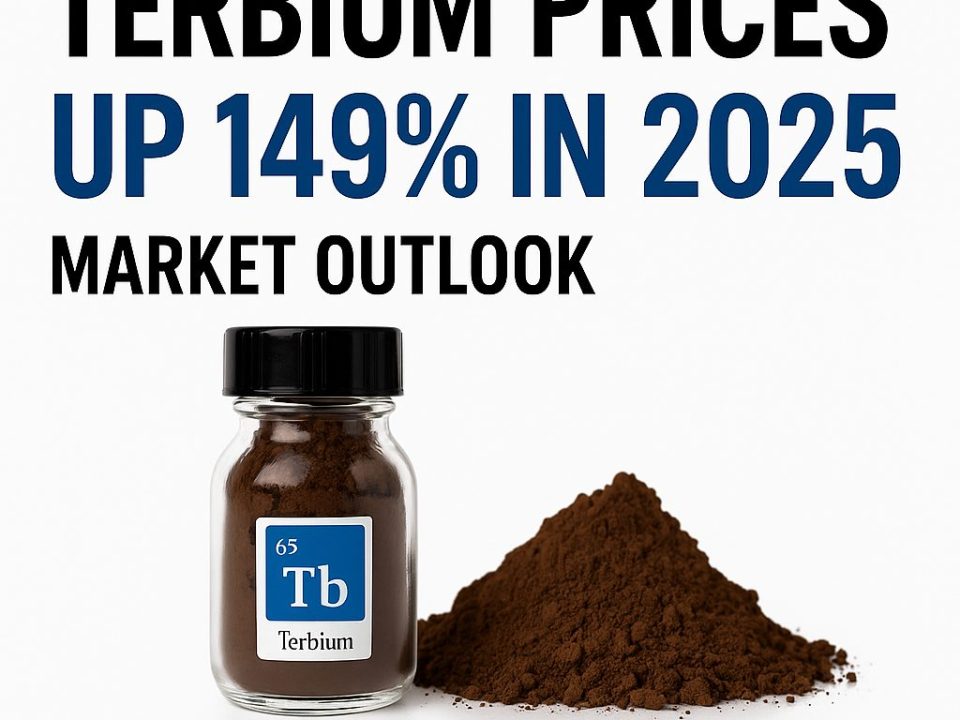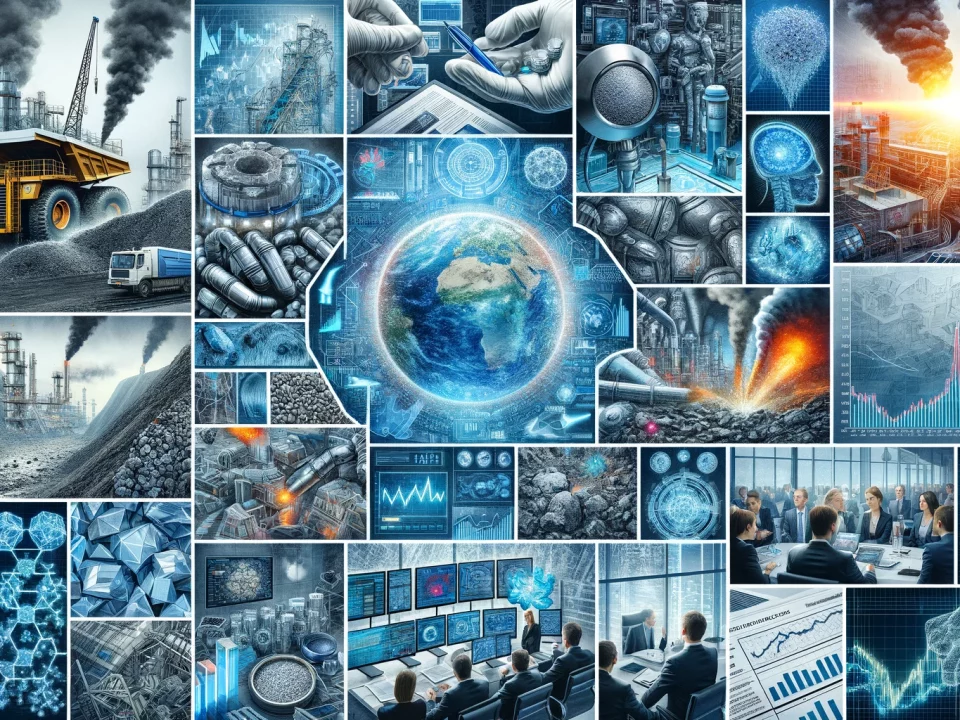
Neodymium Prices Surge in 2025: What’s Driving the Rare Earth Revival?
November 13, 2025
Weekly News Review October 17 – November 23 2025
November 23, 2025What a week it has been. We have now entered Cold War 2.0, and this time it is not an arms race; it is a race for semiconductors, computer chips, magnets – in short, economic superiority, most advanced technologies, and of course, security and military applications. Strap in – we are in for quite a ride as we evolve from globalization to de -globalization to resource nationalism.
All the latest provided from our editorial team at @rohstohf.net
UNITED STATES ADDS TEN NEW MATERIALS TO 2025 CRITICAL MINERALS LIST:
Copper, silver, rhenium, and silicon are now among those deemed vital to the U.S. economy and national security.
The U.S. Geological Survey (USGS) has released its updated list of critical minerals for 2025, identifying materials considered essential to the U.S. economy and national security, as well as vulnerable to supply chain disruptions.
Compared with the 2022 list, 10 new commodities have been added: boron, copper, lead, metallurgical coal, phosphate, potash, rhenium, silicon, silver, and uranium. The total number of minerals designated as critical now stands at 60.
Several of the additions, including copper, silver, and rhenium, were already proposed in a draft list published by the USGS in August for public consultation (we reported). At the time, the agency also considered removing arsenic and tellurium, citing changes in global supply chain dynamics, but ultimately decided to retain them in the final version.
According to the USGS, the list is intended to guide future U.S. raw materials policy, including investment priorities, stockpiling strategies, and permitting decisions. The updated classification was developed using an economic modeling system designed to assess the potential impact of trade disruptions. In total, the analysis encompassed 84 mineral commodities, 402 industry sectors, and over 1,200 scenarios.
The USGS, part of the U.S. Department of the Interior, updates its list of critical minerals at least every three years. The Department of Energy (DOE) and the Defense Logistics Agency (DLA) also maintain their own lists of strategically essential materials to support the military and key industrial sectors.
UNITED STATES SECURES SAMARIUM, DYSPROSIUM, AND MORE SUPPLY DEALS FOR DOMESTIC SUPPLY CHAIN:
The Belgian chemical company Solvay has signed two new supply agreements with U.S. magnet manufacturers.
Solvay, which produces rare-earth concentrates and separated products at its La Rochelle, France, facility, will supply samarium to Permag and Less Common Metals. Samarium–cobalt magnets are significant for military applications due to their high heat resistance.
Permag claims to be the only producer of such components in North America. The UK-based company Less Common Metals will contribute its expertise in metallization processes to the partnership.
A second agreement was concluded with Texas-based Noveon Magnetics, granting the U.S. manufacturer access to a range of rare-earth oxides, including dysprosium and terbium.
These and other recent deals underscore U.S. companies’ active pursuit of alternative, non-Chinese sources of raw materials while developing domestic capabilities to produce specialized components. Recently, USA Rare Earth announced plans to acquire Less Common Metals to strengthen its technological base.
Solvay CEO Philippe Kehren has also indicated openness to expanding production capacity in the U.S., noting in a Reuters interview that the business environment and political support there are far more favorable than in Europe.
CHINA SUSPENDS EXPORT BAN ON GALLIUM AND GERMANIUM TO THE UNITED STATES:
Announcement follows a meeting in Korea between U.S. President Trump and China’s Xi Jinping.
China has temporarily lifted its export ban on several critical materials to the United States, including gallium, germanium, antimony, and so-called superhard materials. The suspension, which will last for about a year, aligns Beijing more closely with Washington’s position on easing trade restrictions on key minerals.
The White House announced on November 1 that, following bilateral negotiations, China would facilitate the export of certain critical minerals, including rare earth elements, gallium, and germanium, to U.S. end-users and their suppliers.
Previously, China had only referred to a one-year suspension of its latest globally applicable export measures, introduced in early October. These measures had targeted mainly the rare-earth value chain and were partially implemented immediately. Last Friday, China officially enacted the suspension (as previously reported).
However, earlier export controls appear to remain in effect, as Beijing has not yet issued any statements lifting them. These include restrictions introduced in April 2025 on specific rare-earth elements, as well as the global export curbs on gallium and germanium first imposed in the summer of 2023. China is the world’s leading producer of these and other critical raw materials. After the restrictions were introduced, exports temporarily dropped sharply, and in some cases, to zero. Notably, even before the official ban, virtually no gallium or germanium had been exported to the U.S.; the last shipment was recorded in June 2023, according to Chinese customs data.
The backdrop to Beijing’s measures is the ongoing trade conflict with the United States. The export restrictions were officially justified on national security grounds, as materials such as gallium, germanium, and rare earths are used not only in civilian industries but also in advanced military technologies.
CANADIAN COMPANY SECURES $140 MILLION TO ADVANCE TEXAS RARE EARTH PROJECT:
The Canadian company plans to recover the critical minerals from mining tailings.
Canadian exploration and development company Tactical Resources Corp. has secured up to $140 million in financing from Yorkville Advisors Global to accelerate development of its Peak rare earths project in Sierra Blanca, Texas. The company plans to recover and process rare earth elements from existing tailings, waste material left from previous mining operations, rather than developing new mines. This approach could shorten development timelines and help supply North American industries with critical minerals more quickly compared to building a new mine from scratch.
Located about 113 km southeast of El Paso, the Sierra Blanca quarry currently produces ballast material for the Union Pacific railway, crushed rock that provides stability and support for railway tracks. Under an agreement with the quarry operator, Tactical Resources has secured, for a fee, the right to access tailings material believed to contain rare earth elements. The company also holds an option to acquire the mining lease, which would give it control over the entire quarry operation.
The concentration and recoverability of REEs within the tailings have not yet been fully confirmed, which could affect the project’s economic viability. Tactical Resources plans to conduct additional sampling and testing programs in the near term to better define the project’s potential and advance toward a maiden resource estimate.
IEA (INTERNATIONAL ENERGY AGENCY) – RESOURCE DEPENDENCE THREATENS GLOBAL ENERGY SECURITY –
The International Energy Agency warns that growing dependence on critical minerals and a slower energy transition could put global energy security and climate goals at risk.
In its new World Energy Outlook 2025, the International Energy Agency (IEA) projects, for the first time in years, that global demand for fossil fuels will continue to rise through 2050, rather than decline as previously expected. According to the report, the energy transition is progressing more slowly than anticipated, making it increasingly unlikely that global climate targets will be met. The IEA cites sluggish electrification of transport, delays in expanding renewable energy, and shifting political priorities, particularly in the United States, as key reasons for this trend.
Alongside its “current policies scenario,” the IEA modeled several alternative development pathways. However, in every case, global warming is projected to exceed the 1.5°C limit agreed upon at the 2015 Paris Climate Conference. Only in the Net Zero Scenario could temperatures eventually decline again, provided that large-scale carbon removal technologies are deployed.
Rising Power Demand and Growing Risks in Critical Minerals:
All scenarios indicate a significant increase in global electricity demand, driven by electric mobility, heating and cooling, data centers, and artificial intelligence. Emerging economies, particularly in India, Southeast Asia, Africa, and Latin America, are expected to account for a substantial share of this growing demand.
At the same time, the IEA warns of mounting risks to energy security, particularly due to the high geographic concentration of critical minerals. China currently controls about 70 percent of global refining capacity for key materials used in batteries, power grids, electric vehicles, AI chips, and military technologies. Moreover, Beijing has increasingly imposed export restrictions on materials such as gallium, lithium, and rare earth elements.
The agency stresses that accelerating diversification of these supply chains will require stronger international cooperation and more decisive political action, a warning it has issued repeatedly in recent years.
VIRUS TURNS INTO RARE EARTH CYCLER:
An international team of researchers has turned a virus into a microscopic recycling machine capable of selectively extracting rare earth elements from mine wastewater.
Rare earth elements, essential for smartphones, wind turbines, and electric vehicles, are critical to modern technologies. Yet before these 17 chemically similar elements can be processed, they must be painstakingly separated using energy-intensive, environmentally harmful methods. The chemicals typically used in conventional extraction can cause significant pollution, driving the search for greener alternatives.
Now, scientists led by the University of California, Berkeley have refined a biological approach that transforms a virus into a selective “recycling tool.” The team genetically modified a bacteriophage, a virus that infects only bacteria and poses no danger to humans or the environment, by adding two special proteins to its surface.
One of these proteins acts like a molecular claw or a bright sponge, capable of binding rare-earth elements in solution. The second protein functions as a temperature-sensitive switch: when the liquid is gently warmed, the viruses, with their captured metals, settle to the bottom of the tank. After draining the fluid, the bound metal ions can be released by adjusting the pH level.
The process has already been successfully tested on acidic mine wastewater, a byproduct of past mining activities that often contains valuable residual metals.
Greener and Cheaper Than Conventional Methods:
According to the researchers, their virus-based system is both more environmentally friendly and more cost-effective than traditional separation technologies. The modified phages remain efficient even after multiple recycling cycles, offering a durable and sustainable extraction tool.
The system can also be adapted for other uses, such as recovering rare earths from electronic waste or extracting other critical minerals, including lithium, cobalt, and platinum group metals. “It could even be used to clean water contaminated with toxic heavy metals like mercury or lead,” explains Seung-Wuk Lee, Professor of Bioengineering at UC Berkeley and co-author of the study.
The next phase of research, supported by the Rio Tinto Centre for Future Materials, will explore how the method can be applied to copper recovery. The centre, established by the mining company in collaboration with several universities, focuses on developing sustainable technologies and materials for the energy transition and greener resource extraction.
CANADA TO TAKE STEPS IN CRITICAL MINERAL PROJECTS:
Canada is preparing to take direct ownership stakes in mining and processing projects for critical minerals, stepping up its efforts to secure supplies of materials that China currently dominates—in an interview with Bloomberg, Natural Resources Minister Tim Hodgson stated that the government has begun reviewing projects that could receive equity funding through its recently unveiled $1.6 billion (C$2 billion) Critical Minerals Sovereign Fund, which is part of the upcoming budget. The focus includes rare-earth processing facilities and mines deemed strategically necessary but unable to attract sufficient private investment.
Ottawa is also fast-tracking approvals for several mining developments, including Nouveau Monde Graphite’s Phase 2 project in Quebec, Canada Nickel’s Crawford project in Ontario, and a tungsten–molybdenum mine in New Brunswick. Canada additionally plans to expand its stockpiles of minerals such as scandium and graphite, and is assessing other materials where domestic supply remains limited.
The Canadian measures mirror a growing U.S. push to rebuild critical-material supply chains outside China. Recent actions include the U.S. Department of Commerce’s $50 million stake to support Vulcan Elements’ expansion, and the Pentagon’s earlier strategic investment in rare-earth producer MP Materials to boost domestic processing and magnet production.
GERMAN STARTUP SECURES $100 MILLION FOR HAFNIUM-BASED MEMORY CHIPS:
German company FMC aims to set new industry standards.
The German semiconductor start-up FMC, short for Ferroelectric Memory Company, has raised €100 million in funding. Of this, €77 million comes from private investors such as HV Capital and Bosch, while the remainder is provided through government research grants. The funds are intended to accelerate the market readiness of FMC’s memory chips.
The technology relies on hafnium oxide applied to a silicon base, the key material for semiconductor chips. According to the Dresden-based company, these chips are significantly faster, more cost-effective, and more energy-efficient than established alternatives. They can retain information without a continuous power supply, drastically reducing energy consumption. Key applications include AI data centers and edge AI devices that process data directly on-site.
Suppliers from Asia and the U.S. currently dominate the memory chip market, the German Handelsblatt notes. The last major European manufacturer, Qimonda, went bankrupt in 2009. FMC’s technology, however, is developed based on knowledge acquired from Qimonda.
One of the Largest Funding Rounds in the European Semiconductor Sector:
The start-up plans to source its components from contract manufacturers initially and describes the funding round as one of the largest in Europe’s semiconductor sector. On a global scale, however, the amount is relatively modest, according to Handelsblatt. Analysts also note that competing memory chip technologies exist, leaving it uncertain whether FMC’s system will become the new industry standard.
Nevertheless, the announcement could have a signaling effect for Europe’s semiconductor industry. With its 2022 Chips Act, the EU set ambitious goals for the domestic sector, goals that are now widely considered unlikely to be met. Further setbacks include the cancellation of several U.S. companies’ plans to build semiconductor plants in Europe. At the same time, most European companies reliant on chips express a strong desire for greater resilience in local supply chains, according to a recent survey by the German digital association Bitkom.






